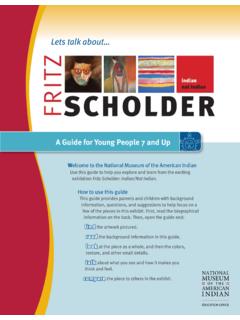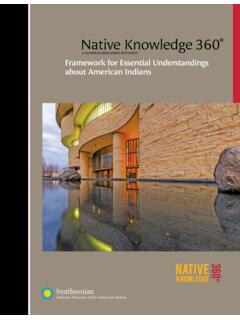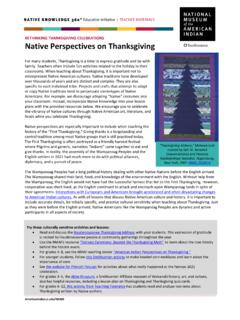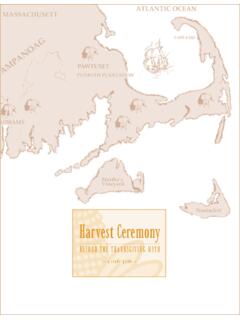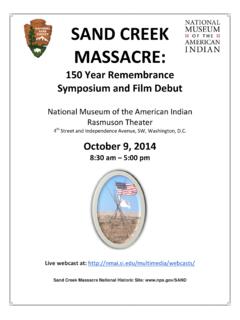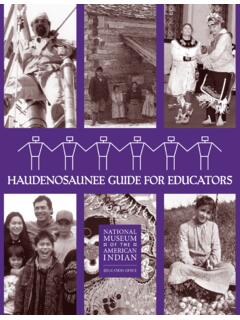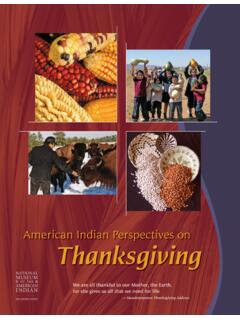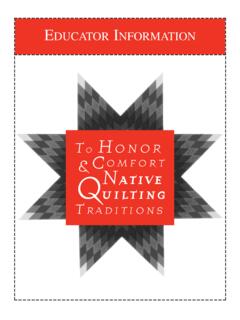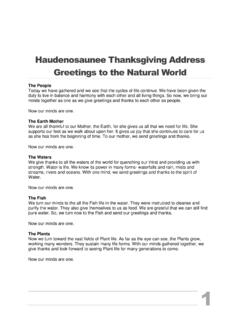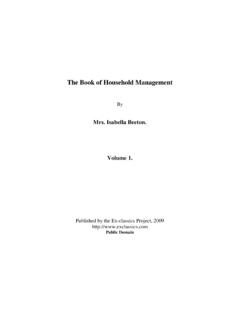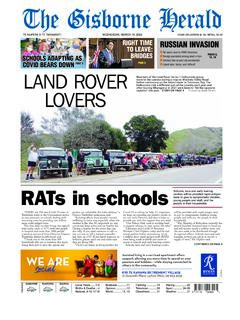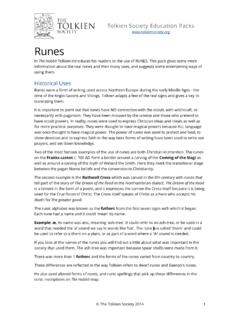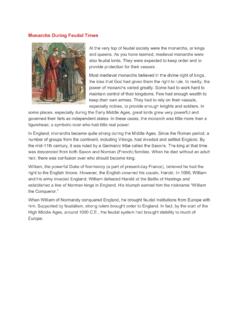Transcription of Beauty Surrounds Us - Smithsonian Institution
1 Beauty Surrounds Us celebrates the harmonious and graceful aesthetics present in all of these objects from everyday tools and games to ceremonial regalia. When I look through these stunning masterworks from the delicate ornaments made with beetle wings to the elk tooth dress made for an undoubtedly special little girl it is sometimes difficult to remember that they were never meant to be in a museum. They were used and worn by real people not unlike the visitors, students, and travelers we welcome everyday here at the George Gustav Heye Center. The ideas that shaped Beauty Surrounds Us are also echoed in this glorious new space, the new Diker Pavilion for Native Arts and Cultures.
2 Inspired by Native works, the Pavilion serves as a center for Native art and performance, an education facility for schoolchildren, and a gathering place for all the com munities we are privileged to serve. I am so pleased that this breathtaking presentation of Native American art, culled from the museum s renowned collection, is the inaugural exhibition of the Diker Pavilion for Native Arts and Cultures. John Haworth (Cherokee) Director, George Gustav Heye Center National Museum of the American Indian Huastec conch shell trumpet, AD 900 1500. Panuco, Veracruz, Mexico. Conch shell. 24/3562 In many indigenous cultures, conch shells provide a source of food as well as the raw material for making musical instruments.
3 To make this conch shell trumpet, a Huastec artist cut or filed the top of the shell to create a mouthpiece. A musician controlled the trumpet s tone by positioning his hands inside the opening of the shell. This exhibition presents an array of breathtaking and culturally significant objects made by Native peoples throughout the Western Hemisphere. Each piece reveals the individual artistic expression of its maker. Each affirms the deeply rooted connection to the culture from which it hails. Together, these creations illustrate the richness and vitality of indigenous life, past and present, and demonstrate that Native peoples have always surrounded themselves with things of Beauty .
4 Most indigenous peoples made everyday objects clothing, tools, musical instruments, and accessories that were functional and pleasing to the eye. Individuals drew on time-honored cultural and spiritual beliefs to shape and decorate their creations. Today indigenous artists continue to create breathtaking works that maintain the connection between the past and present. Their skilled hands ensure that Beauty Surrounds us. Johanna Gorelick, NMAI, 2006 - Nurturing Identity Clothing nurtures and reflects identity. By wearing specific clothing styles or designs, Native men, women, and children communicate who they are and where they are from.
5 The outfits children wear look the same as adults clothing, affirming their importance in Native society. This case displays clothing made for and worn by Native children from Alaska, the Great Plains, the Southwest, and Peru. Sewn from hides and fur or woven from wool, these pieces testify to the investment adults have made to nurture their children s cultural identity and participation in community life. Yup ik boy s parka, ca. 1915. Akiak, Kuskokwim River, Alaska. Arctic squirrel skins, caribou hide, wolf skin, wool yarn. 11/6723 Yup ik women made parkas from hides or sealskins to protect their children from frigid temperatures.
6 Sinew thread and bone needles were used for stitching. Parkas would be paired with pants and mukluks (fur boots), also made from animal skins. Taos Pueblo girl s moccasin boots, ca. 1930. Taos Pueblo, New Mexico. Hide. 24/6645 At Taos Pueblo, young women who have gone through a coming of-age ceremony wear moccasin boots for special social and ceremonial occasions. The boots sometimes include three or four folds, which can be straightened and raised to the thigh. Quechua girl s outfit, ca. 1940. Peru. Wool cloth, rickrack, fur, buttons, dyes. 25/878 Special outfits are worn by young female dancers who participate in contemporary Quechua ceremonies, perform ances, and festivals.
7 This particular outfit is worn while dancing to the Valicha, a song specific to Cusco, Peru. Recreation and Pastimes Native people play games at every stage of life and at many social occasions, including ceremonial gatherings and festivals. Games, such as lacrosse, are of Native origin. Other pastimes, such as cards and cribbage, were brought to the Americas, where Native peoples adopted them and made them their own. LEFT: Inupiaq high-kick ball, ca. 1910. Point Barrow, Arctic Slope, Alaska. Sealskin, moss, sinew. 5/3586 Inupiaq games such as high-kick ball were traditionally played when families or villages gathered together.
8 This ball was made in Point Barrow, Alaska, the northernmost city in the FAR LEFT: Western Apache or Chiricahua Apache playing cards, ca. 1880. Arizona. Hide, paint. 6/4597 By the mid- to late 1800s, American Indians began making their own playing cards. Apaches hand-painted rectangles cut from rawhide to create decks containing forty cards of four suits. BELOW: Inupiaq cribbage board, ca. 1980. Aloysius Pikonganna (1909 1986). Sinrock, Alaska. Walrus ivory, pigment or paint. 25/6729 Cribbage boards fashioned from walrus ivory became popular souvenirs during the Alaska gold rush of the 1890s. They are still produced by Inuit artists today.
9 LEFT: Tlingit frontlet headdress, ca. 1870. Nass River, British Columbia, Canada. Hide, maple or alder wood, ermine skins, abalone, sea lion whiskers, wool cloth, eagle down, paint. 9/6739 A Tlingit chief or other high-ranking individual wears a frontlet headdress to welcome guests to social gatherings. This frontlet so-named because it is worn above the forehead is decorated with the image of an ancestral crest animal, the Beaver. RIGHT: Kayap man s headdress, ca. 1990. Gorotire, Brazil. Cordage, feathers, wool yarn, cotton twine. 25/4894 Roriro-ri caps are often worn by older, privileged Kayap men to indicate their importance in the community.
10 The caps are made by attaching sets of colorful bird feathers to a knotted cordage frame. FAR RIGHT: Flathead man s headdress, ca. 1915. Jocko Reservation, Montana. Wool felt hat, eagle feathers, cotton cloth, glass beads, silk, ribbon, horsehair, peacock feathers, ermine skins. 14/3536 An eagle feather headdress was worn by a warrior who had proven himself worthy in the eyes of his community. By the 20th century, these head dresses became more frequently associated with respect and privilege. Honor and Respect In some Native cultures, tribal members gain prominence by serving the com munity. In others, positions of honor are inherited.
